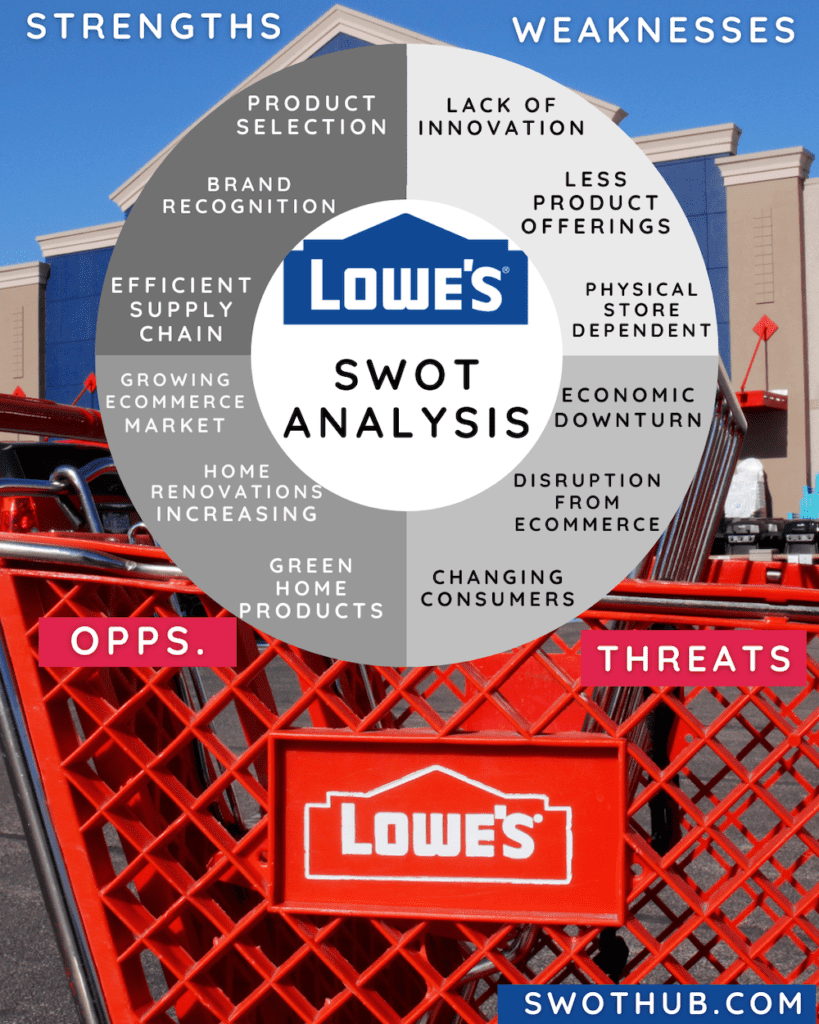The home improvement industry has seen an incredible increase in recent years, with more people staying and working at home due to the pandemic. In Lowe’s SWOT analysis, we take a look at how this small hardware and building material store transformed into the number two home improvement store behind Home Depot. Lowe’s competitors have continued to dominate the market with their online presence and concentration on the volume of home improvement products. Take a look and see if Lowe’s weaknesses and threats can stand down under Lowe’s strengths and opportunities.
Table of Contents
Lowe’s History
In Lowe’s SWOT analysis, we discovered Lowe’s history began with L.S. Lowe in North Wilkesboro Hardware as the first general store opened. In addition to hardware and building materials, the store sold sewing notions, dry goods, horse tacks, snuff produce, and groceries.
In 1940, after his father’s death, Jim Lowe, L.S. Lowe’s son, assumed ownership of the hardware business. Soon after, Lowe enlisted in the military for World War II and extended an offer of stock ownership to Carl Buchan, his brother-in-law.
Lucius Smith Lowe established the Lowe’s chain of hardware and appliance stores in North Wilkesboro, North Carolina, in 1946. The business started as a modest hardware store but quickly grew, opening a second location in 1949. In the 1960s, Lowe’s began to concentrate on bigger stores with a wider selection of goods, and by the 1980s, it had expanded to become a national chain.
For a long time, Lowe’s has offered top-notch products for home improvement projects and top-notch customer support. The business was initially established in 1921 as a general store, but in 1946 it narrowed its focus to only selling home improvement goods. It expanded from there to become a national chain, earning a reputation for being knowledgeable and helpful when it comes to reliability and home improvement selection.
The emphasis of Lowe’s shifted from DIY customers to professionals in 1958. The Lowe’s Employee Relief Fund was established in 1999 to assist employees who were experiencing financial difficulty. In 2007, the business expanded outside of the US, and in 2015 it opened an office in India. Marvin Ellison was appointed president and CEO in 2018, and Lowe’s celebrated its centennial in 2021.
| Company | Lowe’s |
| Industry | Retail, Home Improvement |
| Founder | Carl Buchan |
| Year founded | 1916 |
| CEO | Marvin Ellison |
| Headquarters | Mooresville, North Carolina |
| Number of employees | 340,000+ (2022) |
| Revenue (FY 2022) | US $97 Billion (2022) |
Lowe’s SWOT Analysis:
A SWOT analysis is a framework used to assess a company’s competitive situation and to create strategic planning. By taking Lowe’s strengths, weaknesses, threats, and opportunities, we may better gain in-depth knowledge about Lowe’s company. In this article, we’ll be taking a look at Lowe’s SWOT framework to better understand its competitive position and potential for future growth. See how Lowe’s competitors fare against them and learn about Lowe’s strengths, weaknesses, opportunities, and threats.
What are Lowe’s strengths and weaknesses?
Competing with its main rival, Home Depot, has been one of the biggest difficulties Lowe’s has encountered over the years. Both businesses are in the same industry and serve the same clients by selling comparable goods. Over time, Lowe’s has had to adjust and change to remain competitive.
In the 1980s, Lowe’s started to focus on larger stores that offered a wider range of products, similar to Home Depot. This helped the company better compete in the home improvement market and attract more customers.
As its e-commerce offerings have grown in recent years, Lowe’s has also made a concerted effort to enhance the online shopping experience. This has been a crucial tactic in taking a share in the expanding online home improvement market and competing with online retailers like Amazon.
In addition, Lowe’s has also focused on innovation as a way to differentiate itself from Home Depot. The company has been at the forefront of developing new technologies and products for the home improvement market, such as smart home systems and energy-efficient appliances. This has helped it stay ahead of the curve and attract customers who are looking for the latest and greatest in home improvement products
Lowe’s SWOT Analysis Strengths:
The areas where a company excels above average or in a manner that distinguishes it from its rivals are its strengths. Lowe’s strengths are outlined in Lowe’s SWOT analysis.
Wide Product Range: From tools and hardware to home furnishings and appliances, Lowe’s offers a wide variety of goods. This extensive product selection gives Lowe’s a competitive edge over smaller shops and helps them draw in customers from various market segments.
Strong Brand Recognition: Lowe’s is a well-known brand in the home improvement industry, and it has a loyal customer base. This recognition and brand loyalty can translate into higher sales and customer retention.
Efficient Supply Chain: Lowe’s has a strong supply chain that enables it to quickly replenish its inventory, lower costs, and boost productivity. This allows Lowe’s competitors to have a harder time competing in terms of pricing and availability.
Lowe’s SWOT Analysis Weaknesses:
The weaknesses of a company are those that limit its potential, make it less competitive, and prevent it from achieving its goals. In this section of Lowe’s SWOT analysis, we’ll look at Lowe’s strengths before moving on to some of Lowe’s weaknesses. In Lowe’s SWOT analysis, some of their weaknesses compared to competitors include:
Limited international presence: Despite being a sizable home improvement retailer in the United States, Lowe’s has a smaller global footprint than some of its rivals. For instance, Home Depot has operations in several nations, such as China, Mexico, and Canada, giving it access to a more varied revenue stream and possibly a larger market share.
Narrow product offering: Lowe’s product offering is focused primarily on home improvement products such as hardware, appliances, and building materials. However, some of its competitors, such as Amazon, have a much broader product offering that includes everything from clothing to groceries, potentially making them a more convenient one-stop shop for customers.
Limited brand recognition: In a Lowe’s SWOT analysis compared to some of Lowe’s competitors, like Home Depot or Ikea, Lowe’s does not enjoy the same level of brand recognition. This may make it more difficult for Lowe’s to win over new clients and maintain a competitive edge in the industry.
Dependence on physical stores: It can be expensive to maintain and staff Lowe’s large physical store footprint. Due to its reliance on physical locations, Lowe’s may find it challenging to compete with online merchants who can offer lower prices to customers due to their lower overhead costs.
Lack of innovation: Some customers may perceive Lowe’s as being less innovative than some of its competitors. For example, while Home Depot has invested in technology such as augmented reality to enhance the customer experience, Lowe’s has been slower to adopt these types of innovations.

Lowe’s SWOT Analysis Opportunities:
Lowe’s has several opportunities to get ahead and utilize new ideas. The following portion of Lowe’s SWOT analysis will examine some of Lowe’s opportunities compared to competitors, including:
Growing e-commerce market: There is a chance for Lowe’s to increase its e-commerce capabilities and take a bigger chunk of the online home improvement market given the rising popularity of online shopping. Lowe’s can increase sales and draw in more customers by making investments in its website, mobile app, and digital marketing campaigns.
Expansion into new markets: In markets where it is currently underrepresented or nonexistent, according to Lowe’s SWOT analysis, they have the chance to increase its presence. The business could expand into new product categories like home decor, furniture, or outdoor living, for instance, or it could enter new international markets.
Increasing demand for sustainable products: As consumers become more environmentally conscious, there is a growing demand for sustainable and eco-friendly home improvement products. By offering a wider selection of green products and promoting sustainable practices, Lowe’s can appeal to this growing customer segment and differentiate itself from competitors.
Increasing focus on home renovations: There has been an increase in demand for home renovation projects because more people are staying at home as a result of the COVID-19 pandemic. As a one-stop shop for customers’ needs, Lowe’s can take advantage of this opportunity by promoting its goods and services that are geared toward home renovation projects.
Lowe’s SWOT Analysis Threats:
Threats pose a risk to every company’s stability and profitability. This article on Lowe’s SWOT analysis will address some of the threats that are important to examine. In a SWOT analysis, some of its largest threats compared to competitors include:
Economic conditions: The home improvement retail industry is highly dependent on economic conditions. A slowdown in the economy or a decrease in consumer spending could lead to lower sales and profitability for Lowe’s.
Disruption from e-commerce: E-commerce has disrupted many industries, including retail, and home improvement is no exception. Lowe’s may face increased competition from online retailers such as Amazon, which can offer lower prices and greater convenience to customers.
Supply chain disruptions: To get goods to its stores, Lowe’s relies on a complex supply chain. Any supply chain disruption, such as natural disasters or labor strikes, could result in shortages and higher prices, which would have an impact on the company’s profitability.
Changing consumer preferences: Consumer preferences and trends can change quickly, and Lowe’s needs to adapt to these changes to stay relevant. For example, if customers shift towards eco-friendly or sustainable products, Lowe’s may lose market share if it does not offer a wide selection of sustainable and eco-friendly products. In a Lowe’s SWOT analysis, they need to ensure that interior design and construction trends in the home improvement space are influencing their product offerings.
What is Lowe’s competitive advantage, and who are Lowe’s competitors?
Since Lowe’s early beginnings, its name has been known to keep long-time loyal customers coming through its doors for home improvement needs. Their e-commerce opportunities also help them keep a competitive advantage in Lowe’s SWOT analysis.
Online Presence: Lowe’s has a significant online presence that includes a user-friendly website, mobile app, and online marketplace. This helps to attract tech-savvy customers and provide a convenient shopping experience.
Customer Service: Lowe’s is renowned for offering top-notch customer service, which includes helpful staff and simple returns. This may increase customer trust and give your business a competitive edge over other retailers of home improvement products.
In a SWOT analysis of Lowe’s, its competitors would fall under the “threats” category.
Here are Lowe’s main competitors:
- Home Depot
- Walmart
- Amazon
These companies have a larger market share, greater brand recognition, and often offer lower prices, making it difficult for Lowe’s to compete effectively.
Lowe’s SWOT Analysis: Conclusion and Recommendations:
Lowe’s needs to focus on several key strategies to remain competitive in the home improvement products industry:
Lowe’s has a strong position in the construction and home improvement market with a robust financial standing, extensive product offerings, and an established presence in multiple locations.
FAQs for Lowe’s
What are the competitive advantages of Lowe’s?
Lowe’s competitive advantages include a strong brand reputation, an extensive product range, a robust supply chain, and the effective use of technology in operations. These factors contribute to its market position and customer loyalty.
What are the weaknesses of Lowe’s in a SWOT analysis?
In a SWOT analysis, Lowe’s weaknesses include limited global presence compared to some competitors, reliance on the U.S. market, and challenges in adapting to rapidly changing consumer preferences and technological advancements.
What are Lowe’s strengths?
Lowe’s strengths lie in its large network of stores, strong relationships with suppliers, diverse product offerings, and effective marketing strategies. These strengths enable Lowe’s to maintain a solid market position and attract a broad customer base.
However, there are still areas where Lowe’s can improve:
- Lowe’s should continue to enhance their online presence and invest in technology and automation.
- Lowe’s also needs to keep expanding their international operations
- To stay ahead of Lowe’s competitors and continue dominating the market, Lowe’s needs to focus on these areas and be agile in adapting to changing consumer needs and preferences.
- By implementing these recommendations, Lowe’s can continue to meet the demands of consumers and maintain its position as a leader in the home improvement market





